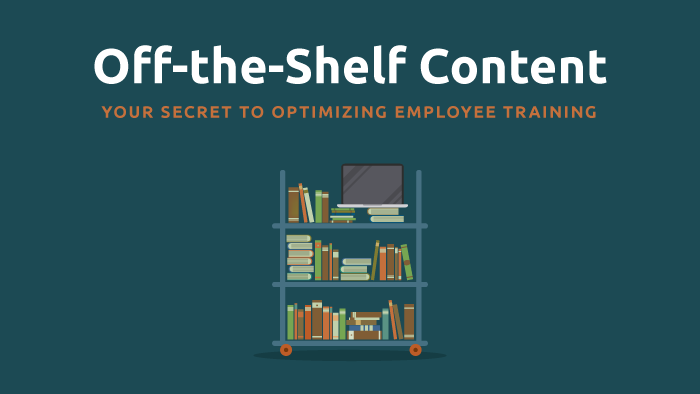Instructional Designers (IDs) play a critical role in the learning process. They are charged with evaluating elearning materials, creating educational content, designing and developing courses, and creating training materials for an organization.
So, when it comes to off-the-shelf content, IDs may feel like their toes are being stepped on. However, that shouldn’t be the case. There are benefits to using both in-house content and off-the-shelf content at the same organization.
Time Spent Creating Training Content
From ideation to design to execution, training takes a lot of time to create. An Association of Talent Development study found the average time it took to create different types of training.
Instructor-led classroom training takes about 67 hours to develop, while instructor-led online training takes 55 hours.
For elearning, development ranges from 48 hours (on videos that have no interactivity) up to 155 hours (on videos that are highly engaging, whichincludes games and/or simulations).
This means weeks’ worth of time is spent creating one training module. If your organization isn’t leveraging off-the-shelf content, IDs would be spending their time creating those lessons.
Rather than having instructional designers spend time creating content that’s already available, you can purchase off-the-shelf content for these topics and let IDs focus on the proprietary training your company needs.
Cost of Developing Training Content
The cost of developing training content depends on the type of training, the complexity of the training, the length of the training, and the people involved in the development process. Creating online learning courses can often involve subject matter experts, an ID team, project managers, content development specialists, and technical staff.
An ID at Sendoso laid out what the costs would be for different types of training:
Leadership Training
Using industry averages, about 25% of a given year is spent on developing leadership training. That equals about 13 weeks. Assuming that IDs make $36.00/hr and trainers make $31.25/hr, that’s a total of $18,720 for IDs and $16,250 for a trainer, totaling $34,970 to deliver leadership training.
Sales Training
As above, industry standards were applied to the development of sales training, and about 55% of a given year, or 28.6 weeks, is spent on developing sales training. With IDs making $36.00/hr and trainers making $31.25/hr, that’s a total of $41,184 for IDs and $65,000 for a trainer, totaling $106,184 to deliver sales training.
With high price tags like this, it’s clear that off-the-shelf content can save companies money in the long run, since that’s a lot of time and energy spent on one type of training.
Ease of Utilizing Off-the-Shelf Content
Off-the-shelf content is usually “straight out of the box” and requires no additional content or development. It covers a wide range of topics and is great for teaching and training on topics like soft skills, computer software, and customer service. Since it is developed by industry professionals, it’s polished, high-quality content that ensures the same information is disseminated across an organization.
This is beneficial for IDs because they don’t have to reinvent the wheel. Since the content is already created, it’s ready to be implemented immediately. There is no lead-in or development time, so IDs are able to spend their time focused on content specific to their organization.
Time-to-Learning Metrics
With that, it’s important to consider time-to-learning metrics. That is, the total time between the moment that a learner starts a training until they deliver feedback. Benefits of knowing this metric include:
- Setting goals: Knowing these metrics will help the team be more focused on what needs to be achieved and what goals need to be set.
- Faster learning: Getting this relatively quick feedback allows development teams to better understand their learners and their needs more quickly. They can see how enhancements and new features were handled and adapt moving forward.
Choosing Off-the-Shelf Content
When choosing your off-the-shelf content there are some important features to look for.
Interactivity
Interactivity refers to how learners interact with the training content, and it provides many benefits to learners.
Learners can freely explore their learning environment how they want and do so at their own pace. Being able to explore freely, employees can develop their decision-making skills in a risk-free environment, and making their own choices keeps engagement high.
Adding in visual components, hyperlinks, etc. that make the content more eye-catching and encourage exploration, result in a better overall learning experience.
Quiz Questions
Using quiz questions throughout or after your training is a great way to measure and test the knowledge of your employees on training topics. There are a variety of question types that can be used, including multiple choice, true or false, and fill-in-the-blank.
As an added bonus, you can use questions as a learning retention tool. Learners forget 70% of information within the first 24 hours. By sending out review questions on a pre-determined basis, questions can be used to help learners retain information.
BizLibrary offers boosts for lessons within The BizLibrary Collection, which helps reinforce learning by sending questions, surveys, polls, and more to learners to gauge and improve their retention.
Customization Options
Customizing off-the-shelf content is a great way to add your company’s familiar branding to already-created content. You’re able to input company-specific information and add in the above quizzes and interactions. Being able to tailor the content to your organization can provide a more integrated feel and help align your training programs to your specific company goals.

